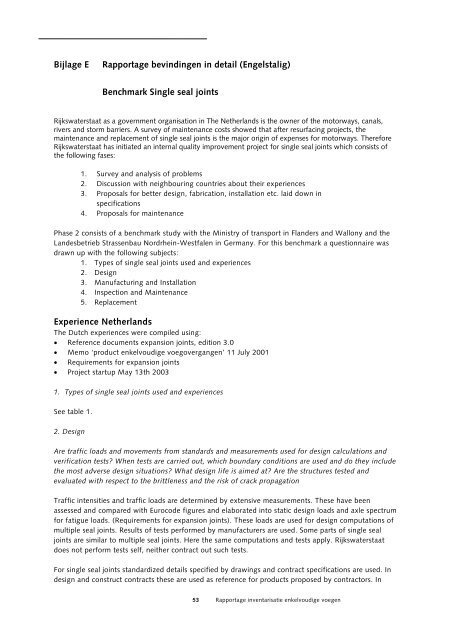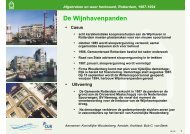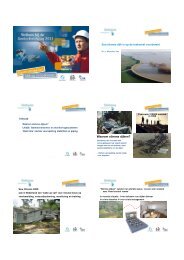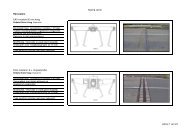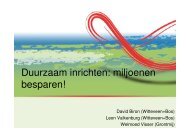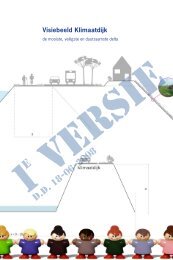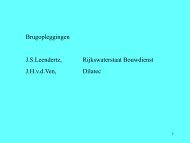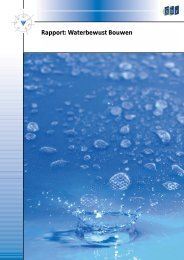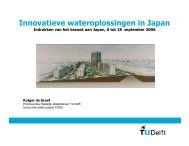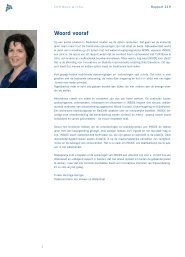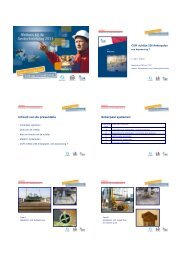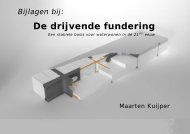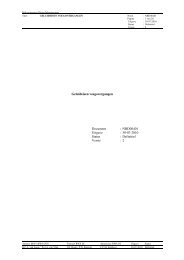Rapportage inventarisatie enkelvoudige voegen - Curnet
Rapportage inventarisatie enkelvoudige voegen - Curnet
Rapportage inventarisatie enkelvoudige voegen - Curnet
You also want an ePaper? Increase the reach of your titles
YUMPU automatically turns print PDFs into web optimized ePapers that Google loves.
Bijlage E <strong>Rapportage</strong> bevindingen in detail (Engelstalig)<br />
Benchmark Single seal joints<br />
Rijkswaterstaat as a government organisation in The Netherlands is the owner of the motorways, canals,<br />
rivers and storm barriers. A survey of maintenance costs showed that after resurfacing projects, the<br />
maintenance and replacement of single seal joints is the major origin of expenses for motorways. Therefore<br />
Rijkswaterstaat has initiated an internal quality improvement project for single seal joints which consists of<br />
the following fases:<br />
1. Survey and analysis of problems<br />
2. Discussion with neighbouring countries about their experiences<br />
3. Proposals for better design, fabrication, installation etc. laid down in<br />
specifications<br />
4. Proposals for maintenance<br />
Phase 2 consists of a benchmark study with the Ministry of transport in Flanders and Wallony and the<br />
Landesbetrieb Strassenbau Nordrhein-Westfalen in Germany. For this benchmark a questionnaire was<br />
drawn up with the following subjects:<br />
1. Types of single seal joints used and experiences<br />
2. Design<br />
3. Manufacturing and Installation<br />
4. Inspection and Maintenance<br />
5. Replacement<br />
Experience Netherlands<br />
The Dutch experiences were compiled using:<br />
• Reference documents expansion joints, edition 3.0<br />
• Memo ‘product <strong>enkelvoudige</strong> voegovergangen’ 11 July 2001<br />
• Requirements for expansion joints<br />
• Project startup May 13th 2003<br />
1. Types of single seal joints used and experiences<br />
See table 1.<br />
2. Design<br />
Are traffic loads and movements from standards and measurements used for design calculations and<br />
verification tests? When tests are carried out, which boundary conditions are used and do they include<br />
the most adverse design situations? What design life is aimed at? Are the structures tested and<br />
evaluated with respect to the brittleness and the risk of crack propagation<br />
Traffic intensities and traffic loads are determined by extensive measurements. These have been<br />
assessed and compared with Eurocode figures and elaborated into static design loads and axle spectrum<br />
for fatigue loads. (Requirements for expansion joints). These loads are used for design computations of<br />
multiple seal joints. Results of tests performed by manufacturers are used. Some parts of single seal<br />
joints are similar to multiple seal joints. Here the same computations and tests apply. Rijkswaterstaat<br />
does not perform tests self, neither contract out such tests.<br />
For single seal joints standardized details specified by drawings and contract specifications are used. In<br />
design and construct contracts these are used as reference for products proposed by contractors. In<br />
53 <strong>Rapportage</strong> <strong>inventarisatie</strong> <strong>enkelvoudige</strong> <strong>voegen</strong>


